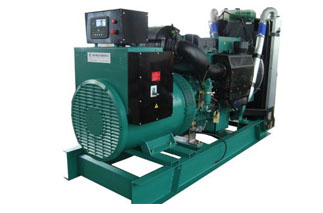
How a generator works
How a generator worksI. electromagnetic induction
We know that all objects are made up of molecules, which are made up of atoms, which are made up of nuclei and electrons rotating around them. The nucleus has a positive charge, the electrons have a negative charge, they attract each other, and they have the same amount of charge.
Take a straight conductor. When the conductor "cuts" the magnetic induction line in the magnetic field, the inductive electromotive force will be generated in the conductor. This is because a conductor in a magnetic field "cutting" magnetic induction line movement, the conductor of the positive charge, free electrons to exercise at the same speed in the magnetic field, magnetic field force movement of charge, for by the left hand rule to judge the direction of the force, so the positive charge by the conductor b end to move to a end, free electrons from the end to move to b end of the conductor. As a result, the end of b gathers electrons and is negatively charged, while the end of a is positively charged without electrons, which results in a certain potential difference between the two ends of the conductor, i.e., an induction electromotive force is generated in the conductor. This is equivalent to a generator running at a constant speed. When an external circuit is connected, an inductive current is formed in the circuit. This is the equivalent of a generator running with electricity.
The direction of induction electromotive force, can be determined by the right-hand rule to: the right hand flat, the thumb and the four refers to the vertical, using the palms face to the lines of magnetic induction, the thumb pointing in the direction of motion of the conductor, the four refers to the direction is the direction of induction electromotive force. Straight conductor of the size of the induced electromotive force and magnetic induction intensity B, conductor velocity v and a conductor is directly proportional to the length L, when parallel to the direction of motion of the conductor and magnetic field direction, do not produce inductive electromotive force in the conductor.
The generation of sinusoidal ac electromotive force
A schematic diagram of a simple generator producing a sinusoidal ac electromotive force.
So let's graph the change in the electrical potential at each of these locations, and we can draw the ac waveform. This type of current (or potential) changing in a sine curve is called sinusoidal alternating current.
Lying on the rotor of the generator of three identical, A 120 ° apart each other independent winding, X, B, Y, C, Z. When the rotor rotates at a constant speed in a sinusoidal distributed magnetic field, three independent symmetric three-phase potentials, eA, EB and EC, are generated.
Basic operating principle of synchronous motor
(1) classification of synchronous motors
According to the operation mode and power conversion direction, synchronous motors are divided into generators and motors. A generator converts mechanical energy into electrical energy, and a motor converts electrical energy into mechanical energy.
According to the structural characteristics, synchronous generators are divided into rotating armature type and rotating magnetic pole type.
Large and large capacity synchronous generator, magnetic pole rotation, armature static, known as rotating magnetic pole type.
Some small capacity synchronous generators, armature rotation, magnetic pole static, known as rotating armature.
Because the armature potential is induced by the collector ring and brush, sparks and abrasion are easily produced when the current is large. Compared with manufacturing process, absolute performance and working reliability, the greater the capacity, the more advantages of rotating magnetic pole type. According to the shape of magnetic pole, rotating magnetic pole synchronous motor can be divided into two types: implicit pole type and convex pole type.
The rotor form of synchronous motor is related to speed. Crypto-type synchronous motor with complex manufacturing process, but high mechanical strength, suitable for high speed. Steam turbine is a high speed prime motor with a speed of 3000r/min. Salient pole synchronous motor, simple structure, but low mechanical strength, suitable for low speed. The general speed of water turbine is 1000r/min, so the water wheel generator is convex pole type. The synchronous motor and the compensator are mostly convex pole type.
Basic structure of synchronous motor
The structure of synchronous motor is basically composed of two parts, one is rotating part is magnetic pole called rotor, the other is static part is armature called stator.
(1) stator
The stator is called armature, so called armature, is the part of the motor that generates the induction electromotive force. It is mainly composed of stator core, three - phase stator winding and stand. Stator core of silicon steel sheet pile into a sector, every 4 ~ 5 cm have ventilating ducts, placed linking piece on both ends of the core, and then use stud from the back of the clamping and become an organic whole, the entire core fixed location on the reinforcement inside the frame, and the stand between the cylindrical shell and core with ventilation. The stator winding is placed in the slot of the inner circle of the iron core and compressed by the slot wedge. The armature winding is made of insulated copper conductor and is wrapped with mica tape or cotton tape according to different rated voltage of the motor. There is insulation between the groove and the winding. A brush holder is arranged on the end cover of the stator, and a brush made of graphite is installed in the grip of the brush holder of the brush holder. Brush and shaft slippage contact, dc current through brush, slip ring into the excitation winding.
(2) rotor
The rotor is composed of a rotating shaft, a rotor support, a wheel ring (i.e. a magnetic yoke), a magnetic pole, and an excitation winding. The magnetic poles are composed of steel plates with thickness ranging from 1 mm to 5mm, and there are magnetic pole pressure plates on the two end faces of the magnetic poles, which are riveted and installed as a whole. The excitation winding is set on the magnetic pole. It is made of flat copper wire. The winding has been treated with glue and hot pressure to become a solid whole. Insulation between winding and magnetic pole. Each excitation winding is connected in series to the slip ring. Rings and rings, rings and shafts, are insulated from each other.
Salient pole synchronous motor in the magnetic pole is also equipped with damping winding, agree it should be the cage of the motor structure similar to that of the whole damping windings by inserting the magnetic damping groove in the end of the article bare copper and copper ring is welded together, as shown in figure 4-52, damping windings can improve the performance of the synchronous generator, for synchronous motor, it is mainly used as starting winding.
The magnetic pole is fixed on the wheel ring, and the bottom of the magnetic pole is made into T tail for assembly with the T tail groove of the wheel ring. Small and medium motors can also be bolted. The large motor wheel ring is made of 2~2.5mm thick steel plate formed by fan-shaped lamination. The rotor is supported by a rotor bracket with sufficient strength.
(3) main parameters of the generator
The main ratings are given on the generator nameplates. In order to ensure reliable operation of generator, these parameters must be strictly observed.
Rated power PN - the maximum power a generator can generate under rated operation (rated voltage, current, frequency and power factor). The units are KW, which can also be expressed as power, in terms of KVA.
Rated voltage UN -- under rated operating conditions, the voltage value of motor stator three-phase line is in units V or KV.
Rated current IN - the line current flowing through the stator winding IN units A or KA during rated operation. Running at this value, the coil's temperature rise will not exceed the allowable range.
Power factor -- ratio of active power to apparent power in rated operation, i.e. :
General electric.
Rated frequency f - rated operating conditions under the output ac frequency. The frequency of China's power grid is 50Hz.
Rated speed nN -- rated operating speed of the rotor, in r/min.
Phase number m -- that is, the number of phase winding of the generator. Commonly used is three-phase ac synchronous generator.
According to the above definition, for a three-phase ac synchronous generator, there is the following relationship between rated voltage, rated current and rated power:
In addition, there are other operating data on the nameplate, such as temperature rise (TN) at rated load, rated excitation current (IfN), rated excitation voltage (UfN), etc.
3) working principle of ac synchronous generator
A simple three-phase ac synchronous generator with rotating magnetic field is shown in FIG. 1-8-14. Dc exciter supplies dc current through brush and slip ring input excitation winding (also known as rotor group) to generate magnetic field. There are three winding axs, BY and CZ with the same structure in the fixed five slots (A, B and C are the beginning end of the winding, while X, Y and Z are the end of the winding). Three winding space position difference of 120 ° electrical point of view.
exciter
When the prime mover drag the motor rotor and exciter rotating, exciter output of the dc current into the rotor winding, produce a rotating magnetic field, magnetic field cutting three-phase winding, produce three equal to the same frequency and amplitude, the corresponding difference electromotive force is 120 °. Let the magnetic flux density of the magnetic field of the magnetic pole be distributed according to the sinusoidal rule along the circumference of the stator, the maximum value of phase potential is Em, and the initial phase Angle of phase potential of A is zero.
When the rotor magnetic pole is a pair, the rotor rotates for a week, and the induction potential changes exactly once in the winding. When the motor has p-pair magnetic poles, the rotor rotates once, and the induction potential changes p times. Suppose the rotor turns to n every minute, then the rotor turns n/60 revolutions every second. Therefore, the induction potential changes pn/60 times per second, i.e., the frequency of the potential is:
According to international regulations, the industrial ac frequency is 50Hz, so there is a strict relationship between the speed of synchronous generator n and the power grid frequency f. When the power grid frequency is constant, the speed of synchronous generator is a constant value. In order to ensure a constant frequency of ac generator, mechanical or electronic governor is installed on the prime motor to achieve stable speed. This is the fundamental difference between synchronous and asynchronous motors.

